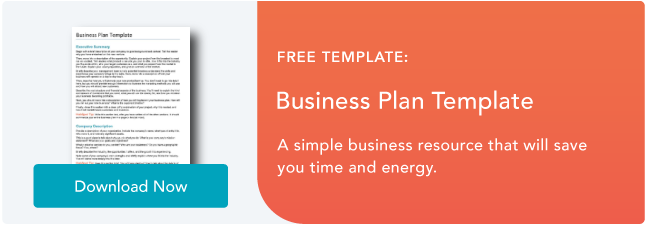Whether you’re an entrepreneur who’s just founded a tech startup or a first-timer who’s just opened the doors of their small local business, you’re probably reading this post to answer one question. How do you get that first customer to click “Sign up” or finally walk through that door?
In this post, I’ll share top tactics for getting your very first real customers — and continue getting clients thereafter.
First up, let’s outline some ways for getting that first customer. While asking your family and friends to buy from your business is always a good idea, that alone isn’t enough to sustain your business for the long term.
What we want to do here is attract customers who will stay with us not because they know us, but because they value our products and services.
1. Write a detailed business plan.
I know, I know; Your new business is already burning resources and racking up expenses, and getting that first customer is instrumental for offsetting costs and finally seeing some cashflow. Sitting down to write a business plan doesn’t seem like the fastest way to get that first client to walk through the door.
Unfortunately, you can’t make sustained profits unless you have a comprehensive business plan in place. Your business plan will be instrumental for attracting the right people to your company and getting your first client to stay with you for the long-term.
If you already have a business plan, then review it at this stage. It will help you better articulate the value you offer when you’re conducting outreach to your network and asking for referrals.
The best part? You don’t have to write it from scratch. Use the template below to get started.
Featured Resource: Business Plan Template
2. Create an ideal customer profile.

Before you ever try to reach out to your first customer, you need to have a theory on who that customer is and what their pain points are. This ideal customer profile (ICP) will help you target people who’ll be more receptive to a cold sales pitch.
Do you think a certain demographic, geography, or job title is more likely to be your customer? What problem do they have that you solve for them today? How are they solving that problem today? Is that the biggest problem that they face?
For example, if I sell a SaaS bookkeeping product for startups, I would start crafting what qualities my ICP should have. In this scenario, I would look for small companies (less than 10 team members) who have an individual who is inexperienced in accounting or managing finances.
These folks are probably paying a third-party accountant or using a costly software such as Quickbooks. My company would help these businesses save money and extend their runway. They’ll therefore be more open to signing up for my software.
If you’re unfamiliar with creating customer profiles, I’ve got good news: You can use the below templates to create them. All you have to do is fill in the blanks.
Featured Resource: Customer Profile Templates
Download Your Free Templates Here
Other tools you might leverage at this stage include:
- Buyer personas: A buyer persona is a fictional representation of your target buyer and a more detailed version of your ideal customer profile.
- Target audiences: In direct contrast with buyer personas, who represent one person, a target audience represents an entire group.
- Target markets: A target market is even more zoomed out than a target audience, representing entire regions and industries where your product might sell well.
3. Start with your own network.
 Now comes the fun part: Actually getting your first client. With your business plan and ideal customer profile in hand, look through your social profiles (LinkedIn, Instagram, Facebook) for connections who might fit your target audience or ideal client profile.
Now comes the fun part: Actually getting your first client. With your business plan and ideal customer profile in hand, look through your social profiles (LinkedIn, Instagram, Facebook) for connections who might fit your target audience or ideal client profile.
For example, if you are selling a new product for prospective homeowners, see who in your network is likely a homeowner. Once you have your list, reach out to these folks using a sequence to explain what you’re building and how you’d like their feedback. These are warm connections you’ve likely already interacted with, meaning it may be easier to get meetings, interest, and early sales.
But as you might have guessed, selling to a social media acquaintance doesn’t automatically mean you have a lucrative business idea. While reaching out to your network is a great place to start, that’s not the only place you should look for customers. We go over more options below.
Recommended Resources
4. Ask for referrals from your network (plus friends and family).
Once you’ve introduced your business to your immediate network, you’ve hopefully already gotten one or two interested parties. These potential buyers aren’t customers yet, but they may know of others who might pull the trigger much more quickly.
You might say something to the effect of: “I’m so glad you’re interested in [product/service], and I’m excited to continue exploring how we can work together. Do you know of anyone else who might benefit from [product/service]?”
You should also ask for referrals from your family and friends, but only if they’re in an industry related to your ideal customer’s. Let’s go back to the bookkeeping software example. If I had a friend who works in operations, they might have a colleague who would benefit from exploring my bookkeeping solution. If I own a dessert shop, then asking my friends to spread the word about my business works, too.
Now, the best part is that you don’t necessarily have to ask for referrals from people who answered your initial message or outreach. Ask those who didn’t respond, too. In fact, asking for a referral is an important step before you “break up” with a potential buyer. If a lead isn’t answering your emails or warming up to your pitch, then the easiest thing for them to do would be to forward you to someone who might.
Recommended Resources
5. Conduct market research and pitch your product.
As you reach out to your immediate network, you should also start conducting market research — which will help you connect with people who may be interested in trying your product.
How? You can start by posting on social channels, forums, threads, and more. No need to adopt an advanced market research method such as focus groups (although you certainly could). Right now, the goal is to post on public places where others might see your business, and where you can interact with potential customers.
For instance, on the r/startups Subreddit, you can post a request for feedback where you get to list your company name, product name, website, and more.

You can even seek beta testers. These testers may not be customers from the start, but may become customers later on after trying your product.
This market research method is non-intrusive, cheap, and easy to execute. Aside from the r/startups example, you can find other relevant Reddit threads and enter social media groups and ask to connect. If you’re having a hard time getting participants, offering some sort of monetary or product incentive for people may help.
The goal is to learn about the prospect, how they are solving the problem today, and if they have started looking into a potential solution. When you are learning about the prospect and their pain, look for opportunities to share your solution.
Go over how it works and how it could help that person. You can incorporate a question such as, "Is that something you would pay for?" If the answer is no, then you can ask why and learn more about your ideal client profile. If yes, ask about their budget and have a lightweight lead generation form on hand to convert that prospect.
Featured Resource: Market Research Kit
6. Use additional outbound prospecting tactics.
Now that you’ve tapped into your network and begun conducting market research, you’re ready to start outbound sales prospecting. You can do this by creating an outreach strategy that targets prospects who fit your ideal client profile.
Once you find a list of prospects who you feel might “bite,” your outreach tactics might include:
- Cold emailing: You can often find the business emails of people by using a tool such as Email Finder. From there, you can send an outreach email that pitches your product and speaks to your idea client’s pain points. Use these cold email templates to increase the chances of a response.
- Cold outreach on LinkedIn: This method involves sending InMail messages to prospects whom you’ve never connected with before. Oscar Estrada, Motion Designer at HubSpot, vouches for this method. He saw success for his small video marketing business after sending hundreds of direct messages on LinkedIn.
- Cold calling: Cold calling is less recommended than other methods because it can be disruptive and unwelcome, but it can be useful if cold emailing or social outreach doesn’t work.
For example, if you are looking to connect with Operations Managers in the Food and Agriculture industry, start by creating a list of people you’d like to chat with on LinkedIn. Once you find those titles, use an email finder tool to get relevant contact information. From here, you can create a custom outreach campaign about the different pains your product can solve.
Remember that for an outbound prospecting strategy to work, you must first qualify prospects to ensure they would be interested in your product in the first place. Sales qualification is the process of measuring up prospects based on the qualities of your ideal client profile. Don’t reach out to just everyone; choose a few who would respond to your pitch based on your research.
Featured Resource: Free Outbound Prospecting Guide
7. Launch your first marketing and advertising campaigns.
As a startup founder or small business owner, you’re likely taking care of your new company’s marketing strategy. Marketing can quickly feel overwhelming if you’re new to the field, so I recommend starting with the following steps:
- Create a marketing plan.
- Start a blog.
- Optimize your website’s SEO.
- Create a lead generation form on your site.
- Implement a social media marketing strategy.
- Launch a paid social media campaign.
- Launch a Google PPC campaign.
Once you have these first steps down, you can delve deeper into a platform that worked particularly well for you, or experiment with other methods such as programmatic advertising.
When creating any paid or organic campaign, target the demographics from your ideal client profile (include factors such as age, location, job title, interests) and see how many early sign-ups you can get.
With most early ad experiments, I wouldn’t recommend spending more than $100. That should be enough to see if you are getting interest. If not, adjust your ad copy or retarget your campaigns.
At a loss? Download our free guide on digital marketing fundamentals to get you up to speed.
Featured Resource: Digital Marketing For Small Business
Learning How to Find Customers for Your Business
Finding customers for your new business will be hard, but it will be worth it — especially after you learn more about your prospects’ needs and create an ideal client profile. With the methods I shared above, you’ll be well on your way to getting your very first customer and turning your new business into a successful venture.
Editor's note: This post was originally published in July 2020 and has been updated for comprehensiveness.
Sales Strategy
.png?width=112&height=112&name=Image%20Hackathon%20%E2%80%93%20Horizontal%20(59).png)







.png)

![7 key sales challenges to prepare for in 2026 [+ how you can overcome them]](https://53.fs1.hubspotusercontent-na1.net/hubfs/53/sales-challenges-1-20251023-788058.webp)
![How B2C sales could shift in a recession [new data]](https://53.fs1.hubspotusercontent-na1.net/hubfs/53/Recession%20sales%20strategies%20(1).png)
![22 Best Sales Strategies, Plans, & Initiatives for Success [Templates]](https://53.fs1.hubspotusercontent-na1.net/hubfs/53/Best-Sales-Strategies-1.png)
![What Is Sales? A Quick Guide [+ Examples]](https://53.fs1.hubspotusercontent-na1.net/hubfs/53/what-is-sales-1-20250411-8755735.webp)

![What Is Cross-Selling? Intro, Steps, and Pro Tips [+Data]](https://53.fs1.hubspotusercontent-na1.net/hubfs/53/ft-cross-selling.webp)

